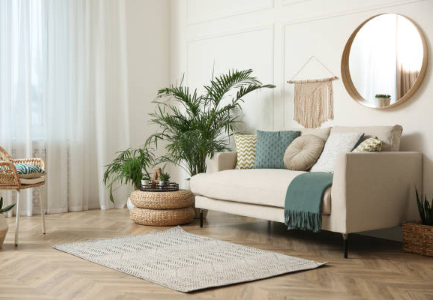
Buying New Carpet? Avoid These Mistakes
December 5, 2023
10 Area Rug Placement Considerations
December 14, 2023The size of the carpet can dramatically change the overall effect of a room. A rug that is too small for your space may cause the room to feel unappealing. Paradoxically, a carpet that is too big for a room can make it feel smaller. A properly sized rug will bring warmth and balance to the room, creating the perfect finishing touch.

Standard Size
When buying a pre-patterned rug, such as an Oriental or Persian rug, the first thing to consider is the standard sizes available. Typically, rugs are available in the following “standard” sizes. (Keep in mind that they may differ by a few inches, big or small.) :
- 3 ft x 5 ft
- 4 ft x 6 ft
- 5 ft x 8 ft (Note: This replaces the previous standard size of 6 ft x 9 ft.)
- 8 ft x 10 ft
- 9 ft x 12 ft

Typically, manufacturers will offer rugs in three or four standard sizes. When looking for a rug, be sure to check the available sizes to make sure your favorite rug has the size you want.
Of course, if you customize your rug, you can make it in the size you want. Rugs made with wide-width rugs have huge benefits, especially if your space is best suited for non-standard sizes.
General Rules for Determining the Size of Your Carpet
The most common mistake people make when buying a rug is choosing a size that is too small for their space. Here are some tips to consider:
- Determine the carpet size based on your furniture configuration rather than the size of the room. This “rule” applies especially to placing rugs in the living room, dining room, or bedroom.
- Match the orientation of the room. For example, placing a square rug in a square room or a longer rug in a long room.
- When in doubt, choose a slightly larger size.
- Don’t be afraid to hide your hardwood or laminate floors; a rug will stand out and enhance its beauty.
- Before buying, use the “tape tips” below to envision a potential rug.

Use the Tape Trick to “See” The Rug
If you can’t imagine how a rug size will fit into a particular room, here’s a trick to help you. Before you buy a rug, measure the floor space according to the dimensions you think you’ll need, based on the standard sizes listed above. Then, use a removable masking tape or something similar that won’t damage the floor, glue the area you just measured. You’ll be able to see the outline of where the rug ends, helping you understand how that size of rug fits into your space. Once you’re happy with the size of your tape area, you’re ready to go for your rug!
Living Room Carpet Layout
When planning your living room, there are a variety of living room rug layouts to choose from.
Bear Down
In this configuration, all furniture is placed entirely on the carpet, and all legs of each piece of furniture touch the carpet. This requires the largest carpet and is perfect for fixing the space in a large room.
Half On, Half Off
Also known as “front legs on top”, furniture is half on the carpet and half on the carpet, with the front legs on the carpet and the hind legs on the floor. This is a convenient option when certain furniture is placed against a wall, as there is no need to cover the hidden floor space with carpet.
No Legs
This option is perfect for small spaces or small rugs. Typically, a centered coffee table is placed on the carpet with the surrounding furniture completely off the carpet and no legs touching the carpet.
Multilayer
You can also create a personalized multi-layered look by layering multiple rugs in creative ways.

One Last Point
Finally, there is one last rule regarding the size of the carpet: rules are meant to be broken. These are just guidelines, and only you can determine what is best for your home because you are the one who has to live in it. The most important thing is to take your time and shop around, as investing in a quality rug is a significant expense. Your home should reflect your taste, so if you want to break any rules, go for it.
Frequently Asked Questions
- How far should the rug be under the couch?
The distance of the carpet under the sofa depends on a variety of factors and styles. The rug can be placed completely under the sofa, half-placed under the sofa, or not at all under the sofa. Check out the Living Room Rug Layout section for ideas.
- What are the good rules for determining the size of your carpet?
A good rule for determining the size of your rug is to choose based on the size of the furniture and the intended layout, not the size of the room.
- What is the most common carpet size for living rooms?
The most common living room rug size is 9 x 12 feet. However, living rooms come in all shapes and sizes. Before choosing an area rug, consider the unique combination of living room size, living room shape, and living room furniture.



